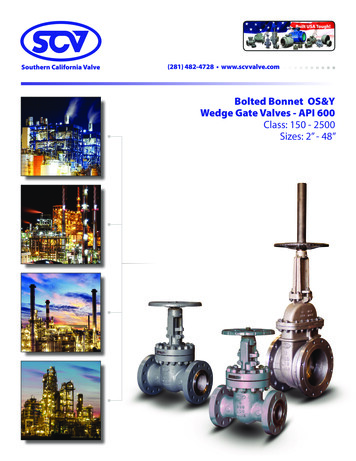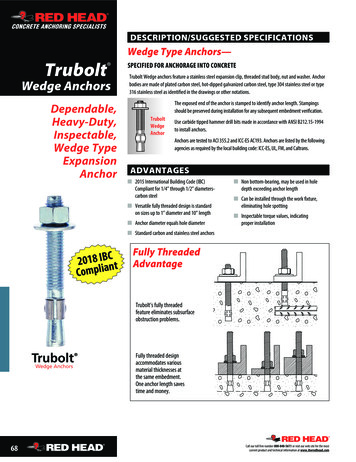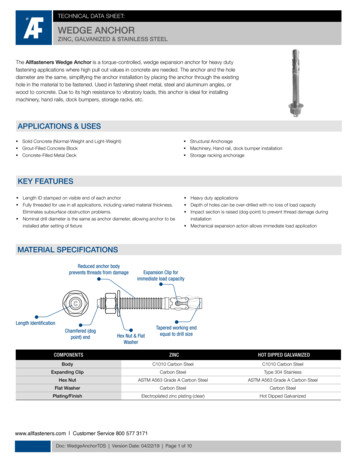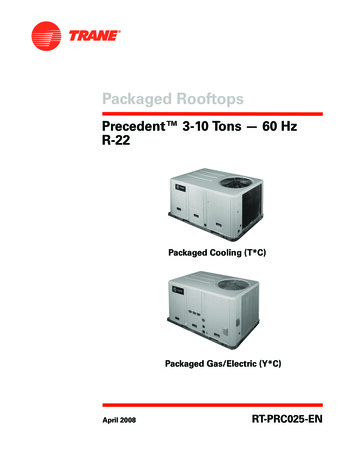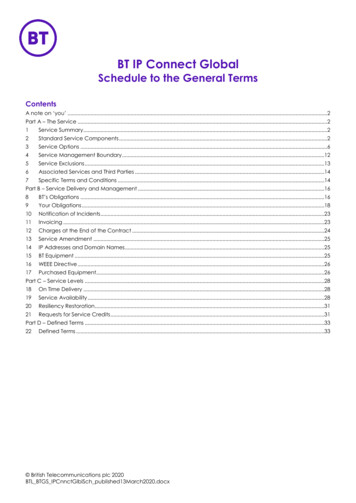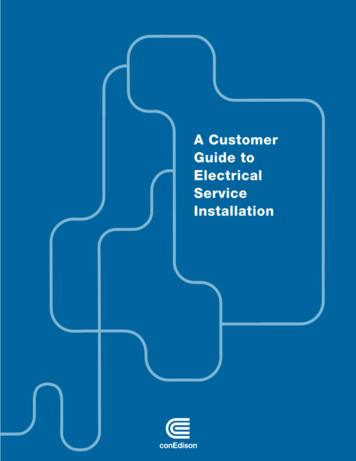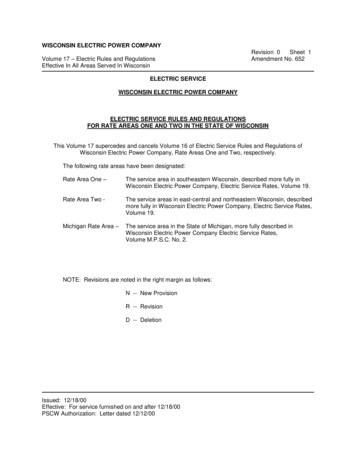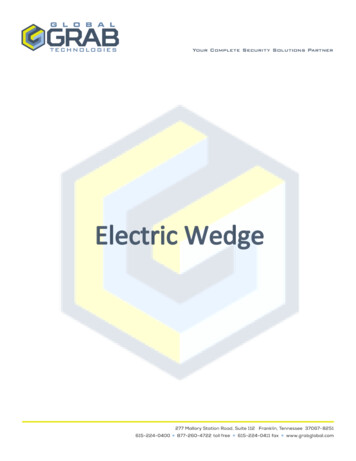
Transcription
Electric Wedge
SECTION 34 71 13.19ACTIVE VEHICLE BARRIERS03/2014PART 11.1GENERALREFERENCESThe publications listed below form a part of this specification to theextent referenced. The publications are referred to within the text by thebasic designation only.AMERICAN ASSOCIATION OF STATE HIGHWAY AND TRANSPORTATION OFFICIALS(AASHTO)AASHTO HB-17(2002; Errata 2003; Errata 2005, 17thEdition) Standard Specifications forHighway BridgesAMERICAN WELDING SOCIETY (AWS)AWS D1.1/D1.1M(2010; Errata 2011) Structural WeldingCode - SteelASTM INTERNATIONAL (ASTM)ASTM A106/A106M(2011) Standard Specification for SeamlessCarbon Steel Pipe for High-TemperatureServiceASTM D3034(2008) Standard Specification for Type PSMPoly(Vinyl Chloride) (PVC) Sewer Pipe andFittingsASTM F2656(2007) Standard Test Method for VehicleCrash Testing of Perimeter BarriersNATIONAL ELECTRICAL MANUFACTURERS ASSOCIATION (NEMA)NEMA 250(2008) Enclosures for Electrical Equipment(1000 Volts Maximum)SOCIETY OF AUTOMOTIVE ENGINEERS INTERNATIONAL (SAE)SAE J517(2013) Hydraulic HoseU.S. DEPARTMENT OF STATE (SD)SD-STD-02.01(2003; Rev A) Specification For VehicleCrash Test of Perimeter Barriers and GatesU.S. FEDERAL HIGHWAY ADMINISTRATION (FHWA)MUTCD(2009) Manual on Uniform Traffic ControlPage 1
DevicesU.S. NATIONAL ARCHIVES AND RECORDS ADMINISTRATION (NARA)29 CFR 1910Occupational Safety and Health StandardsUNDERWRITERS LABORATORIES (UL)UL 486A-486B1.2(2013) Wire ConnectorsSYSTEM DESCRIPTIONBarrier systems used shall be listed in either the Department of State(DoS) certified or Department of Defense (DoD) approved anti-ram vehiclebarrier lists. Barrier widths shall be 'as certified/approved' on theselists. Alternatively, if a barrier system's width is between the widthsof two listed barrier systems that are identical except for their widths,then that barrier system is also acceptable. Exceptions and acceptablewidths will only be taken from the DoD anti-ram vehicle barrier list. Thedesign and structural materials of the vehicle barrier furnished shall bethe same as those used in the crash tested barrier. Crash test must havebe performed and data compiled by an approved independent testing agency inaccordance with either ASTM F2656 or SD-STD-02.01. Barriers tested andcertified on the previous Department of State standard, SD-STD-02.01 andlisted on the DoD approved anti-ram vehicle barrier list are alsoacceptable.1.3SUBMITTALSGovernment approval is required for submittals with a "G" designation;submittals not having a "G" designation are for information only. Thefollowing shall be submitted in accordance with Section 01 33 00 SUBMITTALPROCEDURES:SD-02 Shop DrawingsInstallation[; G]Equipment[; G]Electrical Work[; G]Detail drawings containing complete wiring and schematic diagrams, and anyother details required to demonstrate that the system has been coordinatedand will properly function as a unit. Show on the Drawings proposed layoutand anchorage of equipment and appurtenances, and equipment relationship toother parts of the work including foundation and clearances for maintenanceand operation. Include with the Detail drawings a copy of the Department ofState certificate of barrier performance.SD-03 Product DataBarrier SystemsA complete list of equipment, materials, including industrialstandards used and how they apply to the applicable component andmanufacturer's descriptive data and technical literature, catalogcuts, and installation instructions. Information necessary todocument a minimum 1-year successful field operation performancePage 2
history for each type of vehicle barrier installed.SD-06 Test ReportsField TestingTest reports in booklet form showing all field tests, includingcomponent adjustments and demonstration of compliance with thespecified performance criteria, upon completion and testing of theinstalled system. Indicate with each test report the finalposition of controls.SD-10 Operation and Maintenance DataBarrier Systems[; G]Operating and Maintenance InstructionsFive (5) copies of operation and maintenance manuals, a minimum of2 weeks prior to field training. One complete set prior toperformance testing and the remainder upon acceptance. Manualsshall be approved prior to acceptance. Operation manuals shalloutline the step-by-step procedures required for system startup,operation, and shutdown. The manuals shall include themanufacturer's name, model number, service manual, parts list, andbrief description of all equipment and their basic operatingfeatures. Maintenance manuals shall include routine maintenanceprocedures, possible breakdowns and repairs, and troubleshootingguide. The manuals shall include equipment layout and simplifiedwiring and control diagrams of the system as installed.1.4DELIVERY, STORAGE, AND HANDLINGProtect components placed in storage from the weather, humidity, andtemperature variation, dirt and dust, or other contaminants. Storestructural materials on sleepers or pallets and protect them from rust andobjectionable materials such as dirt, grease, or oil.1.5EXTRA MATERIALSProvide a manufacturer's standard recommended spare parts package, withcurrent unit prices and source of supply complete with detailed manuals onparts replacement, with each barrier to facilitate 1 year of normaloperation. Give particular consideration to system components which arenot readily available from local or commercial sources and which arecritical to the operation of the system.PART 22.1PRODUCTSRETRACTABLE BARRIERSWhen in the raised position, the total retractable barrier heights shall beno less than 28 inches above the roadway surface and shall be 132 incheswide. When in the lowered position, the retractable barrier shall extendno more than 5/8 inch above the roadway surface. Retractable barriers inthe lowered position shall be capable of supporting a 32,000 pound axleload or a 16,000 pound wheel load. Design for this load shall be inPage 3
accordance with AASHTO HB-17.2.1.1Powered Retractable BarrierThe retractable barrier shall be capable of 240 complete up/down cycles perhour. The retractable barrier motion shall be instantly reversible and shallbe capable of raising the barrier from the lowered position to the raisedposition within 2 seconds during normal use, and within 2 seconds during anemergency. Also, the barrier shall be capable of being lowered from theraised position to the lowered position in not more than 3 seconds.[Retractable barrier shall withstand a 15000 pound vehicle at impact speed of50 mph with maximum barrier deflection or vehicle penetration of 3.3 feet.2.1.1.1Failure Modes of OperationThe system shall be designed to remain in the last commanded position inthe event of hydraulic, electrical, or mechanical failure. A manual pump,or other system, shall be included for operation of hydraulic barrierswithout power.2.1.1.2Electric MotorsUnless otherwise indicated, electric motors shall have [drip-proof][totally enclosed] [totally enclosed fan cooled] enclosures. Allcouplings, motor shafts, gears, and other moving parts shall be fullyguarded in accordance with 29 CFR 1910 Subpart O. Guards shall beremovable without disassembling the guarded unit. For multiple barriersoperated from a single hydraulic unit it is highly recommended that theelectric motor be 3-phase.2.1.1.3SystemThe system shall be designed to maintain the barriers in the raisedposition, without inspection, for periods of time of up to 1 week. If ahydraulic system is used, it shall be equipped with pressure relief valvesto prevent overpressure. The system shall not require continuous runningof the motor to stay in the raised position, excluding the use of manualpinning to do so.2.1.1.4Electric Power UnitThe barrier is operated by a linear servo actuator using a spring assistassembly. The system operates on 208-240 three phase, 60 hertz powersupply. In the event of a power failure, the barrier system can beoperated by an optional battery back-up system. The standard batterybackup system will allow the barrier to operate 3 complete cycles. Theelectrical components used to power and control the barrier are housed inwith a weather resistant NEMA 3R enclosure. The up and down controls areprovided on the front of the enclosure for ease of operation during systemmaintenance. All enclosure field connections are made through a terminalstrip.2.1.1.5Hydraulic Power Unit EnclosureA NEMA Type 3R enclosure as specified in NEMA 250 shall be provided toenclose the hydraulic power unit. The enclosure shall be designed for easyremoval of the hydraulic power unit and other accessories without completePage 4
removal of the enclosure. An access door with hinges and an inside andoutside operable/lockable (exterior) door latch shall be provided.Equipment within the enclosure shall be placed and configured so that allperiodic maintenance can be performed through the access door withoutremoval of the equipment. The enclosure shall be equipped withweatherproof louver vents appropriately sized and located to dissipateinternal heat generation.2.2NAMEPLATESNameplate data shall be permanently attached to each vehicle barrier. Thedata shall be legibly marked on corrosion-resistant metal plates and shallconsist of at least the following:a.Manufacturer's name.b.Model number.c.Serial number.d.Date of manufacture.2.3CONTROL PANELA control panel and control circuit shall be provided to interface betweenall barrier control stations and the power unit. A control panel shall beprovided for the inbound lanes and a separate one for the outbound laneswhere the barriers are located. The control station is defined as the maincontrol panel [and the remote control panel] as shown. The control circuitshall contain all relays, timers, and other devices or an industrialprogrammable controller programmed as necessary for the barrier operation.The control panel shall allow direct interface with auxiliary equipmentsuch as card readers, remote switches, loop detectors, infrared sensors,and [sliding] [swinging] gate limit switches. Loop controllers shall notcause an automatic barrier raise following power loss or restoration. Theenclosure shall be as indicated on the drawings. All device interconnectlines shall be run to terminal strips.2.3.1VoltageThe control circuit shall operate from a 120 volt 60 Hz supply. Thecontrol circuit voltage shall be 24 dc for all external control panels.2.3.2Main (OR MASTER) Control PanelA main control panel shall be supplied to control barrier function. Thispanel shall have a key-lockable main switch with main power "ON" and panel"ON" lights. Buttons to raise and lower each [barrier] [set of barriers]shall be provided. Barrier "UP" and "DOWN" indicator lights shall beincluded for each [barrier] [set of barriers]. An emergency fast operatecircuit (EFO) shall be operated from a push button larger than the normalcontrols and have a flip safety cover installed over the push button ortoggle switch. The EFO shall also be furnished with an EFO-active lightand reset button. [The main control panel shall have a key lockable switchto arm or disable the remote control panel. An indicator light shall showif the remote control panel is enabled.Page 5
2.3.3Remote (OR MAINTENANCE) Control PanelA remote control panel, one panel for the inbound lane(s) and a separatepanel for the outbound lane(s), shall have a panel "ON" light that is litwhen enabled by a key lockable switch on the main control panel. Buttonsto raise and lower each barrier shall be provided. Barrier "UP" and "DOWN"indicator lights shall be included for each barrier. The EFO shall beoperated from a push button larger than the normal controls and have a flipsafety cover installed over the push button or toggle switch. Activationof either EFO will operate all barriers. The EFO shall be interconnectedwith an EFO-active light. When the remote control panel EFO is pushed,operation of the barrier will not be possible from this panel until resetat the main control panel.2.4MISCELLANEOUS EQUIPMENT2.4.1Safety Equipment2.4.1.1Barrier Systems SensorsThe barrier system sensors shall consist of the following:a. Suppression Loops - Two inductive loops whose outputs shall be used toprevent barriers raising when a vehicle is within a prescribed distanceof the barrier. The output of the loops shall override all barrierrise signals until one second after a vehicle clears the suppressionloop.The sensors shall be compatible with the barrier controller and shallfunction as part of a complete barrier control system.2.4.1.2Barrier SignalsPole Top Mounted - Red / yellow (flashing) 8 inch traffic lights shall besupplied for each entrance and exit to alert motorists of the barrierposition. Traffic lights are not required for manual barriers. The yellowflashing light shall indicate that the barrier is fully open. All otherpositions shall cause the light to show red. Brackets shall be supplied toallow the light to be mounted a minimum 4.5 feet above the roadway pavementMast Arm Mounted - Red 12 inch / yellow 12 inch / yellow (flashing) 8 inchtraffic lights shall be supplied for each entrance and exit to alertmotorists of the barrier position. Traffic lights are not required formanual barriers. The yellow flashing light shall indicate that the barrieris fully open.2.4.2HeaterA waterproof barrier heater with a thermostat control and NEMA 4 junctionbox connection point shall be provided for de-icing and snow melting. Theheater shall provide barrier operation to an ambient temperature of minus40 degrees F.2.4.3SignageSignageshall conform to MUTCD .Page 6
2.5FINISHSurfaces shall be painted in accordance with requirements of Section09 90 00 PAINTS AND COATINGS. The roadway plate shall have a nonskidsurface painted white with reflective red 4 inch wide red reflectivestripes 4 inches apart. The barrier front shall be painted white and have4 inch wide reflective red stripes 4 inches apart. The diagonal stripingshould point down and outward from the center of the device.2.6
(AASHTO) AASHTO HB-17 (2002; Errata 2003; Errata 2005, 17th Edition) Standard Specifications for Highway Bridges AMERICAN WELDING SOCIETY (AWS) AWS D1.1/D1.1M (2010; Errata 2011) Structural Welding Code - Steel ASTM INTERNATIONAL (ASTM) ASTM A106/A106M (2011) Standard Specification for Seamless Carbon Steel Pipe for High-Temperature Service ASTM D3034 (2008)

